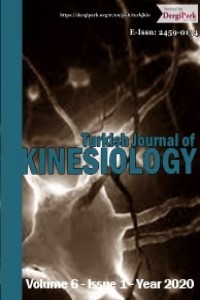Analyzing, investigating and calculating the optimum mode of the parameters affecting the record of the javelin throw including the initial velocity, initial angle, and initial height of throw
Analyzing, investigating and calculating the optimum mode of the parameters affecting the record of the javelin throw including the initial velocity, initial angle, and initial height of throw
The javelin throw is a track and field event, which is of very great antiquity. The most important goal in the javelin throw is the throwing record. In the javelin throw, three factors (initial velocity , initial throw angle and initial throw height H) play a fundamental role in an athlete's record. Throwing record only depends on these three factors, but of course each of them alone is subject to various factors at the time of throwing: the place, time, environmental and physical conditions of an athlete. In this study, these factors were expressed, analyzed and investigated, and the physical, technical and computational parameters with greater precision (from the perspective of sports engineering) were also expressed, and thus the optimum modes for each of them were obtained. The initial throw velocity (V1), initial throw angle (θ1), initial throw height (H), their roles in throwing record and the technical parameters affecting them have been investigated. Results show that the equations of optimum modes were obtained for the three aforementioned variables. Depending on a series of specific initial values for each athlete, an optimum mode of initial velocity, initial angle and initial height of throw were obtained for each athlete, resulting in the maximum record for throwing.
Keywords:
Initial heigh initial velocity, sport engineering, javelin throw,
___
- Bartlett RM, Best RJ. The biomechanics of javelin throwing: A review. Journal of sports sciences, 1988; 6(1): 1-38.
- Bayat MR, Shadmehr B, Rajabi H, Khajavi N. Track and Field (Vol. 2): Jumping and Throwing Events. 9th ed., Tehran: Organization of studying and compiling humanities books of universities (SAMT), 2015.
- Best R, Bartlett R, Morriss C. A three‐dimensional analysis of javelin throwing technique. Journal of sports sciences, 1993; 11(4): 315-328.
- Bosen KO. Coaching Hammer Throwing Technique. Track and Field Quarterly Review, 1985; 85(1): 36-39.
- Dai B, Leigh S, Li H, Mercer VS, Yu B. The relationships between technique variability and performance in discus throwing. Journal of Sports Sciences, 2013; 31(2): 219-228.
- Dai B, Leigh S, Li H, Yu B. The relationships between technique variability and performance in elite discus throwers during competition. The 35th American Society of Biomechanics Annual Meeting, Long Beach, CA, 2011.
- Kunz H, Kaufmann D. Cinematographical analysis of javelin throwing techniques of decathletes. British Journal of Sports Medicine, 1983; 17(3): 200-204.
- David H, Robert R, Walker J. Fundamentals of physics. 11th ed, John Wiley & Sons Incorporated, 2018.
- Leigh S, Gross MT, Li L, Yu B. The relationship between discus throwing performance and combinations of selected technical parameters. Sports Biomechanics, 2008; 7(2): 173-193.
- Leigh S, Liu H, Yu B. Associations between javelin throwing technique and aerodynamic distance. ISBS-Conference Proceedings Archive, 2010.
- Leigh S, Dapena J, Gross M, Li L, Myers J, Yu B. Associations between javelin throwing technique and upper extremity kinetics. The 31st International Conference on Biomechanics in Sports, 2013.
- Liu H, Leigh S, Yu B. Effects of movement sequence on the performance of javelin throwing. International Symposium on Biomechanics in Sports: Conference, 2010a; 28, 1.
- Liu H, Leigh S, Yu B. Sequences of upper and lower extremity motions in javelin throwing. Journal of sports sciences, 2010b; 28(13): 1459-1467.
- Morriss C, Bartlett R, Navarro E, Viitasalo J. The Biomechanics of Elite Javelin Throwing Technique. ISBS-Conference Proceedings Archive, 1995.
- Robinson FC. Modern Technique of Track and Field. Provo, Utah, London: Brigham Young University, 2016.
- Başlangıç: 2015
- Yayıncı: Nurtekin Erkmen
Sayıdaki Diğer Makaleler
The impact of a specific training programme on the selected parameters of swimming turns
Zuzuna PUPİŠOVÁ, Martin PUPİŠ, Jozef SYKORA, David BRUNN, Jana GİNİČOVÁ, Ratko PAVLOVİĆ
Mulay GEBRETENSAY, Soumitra MONDAL, Dhamodharan MATHİVANAN, Mahmud ABDULKADER, Gebretsadik GEBRU, Kedir MOHAMEDHUSİEN
The relationship between CrossFit performance and grip strength
Effect of grit on performance in Crossfit in advanced and novice athletes
